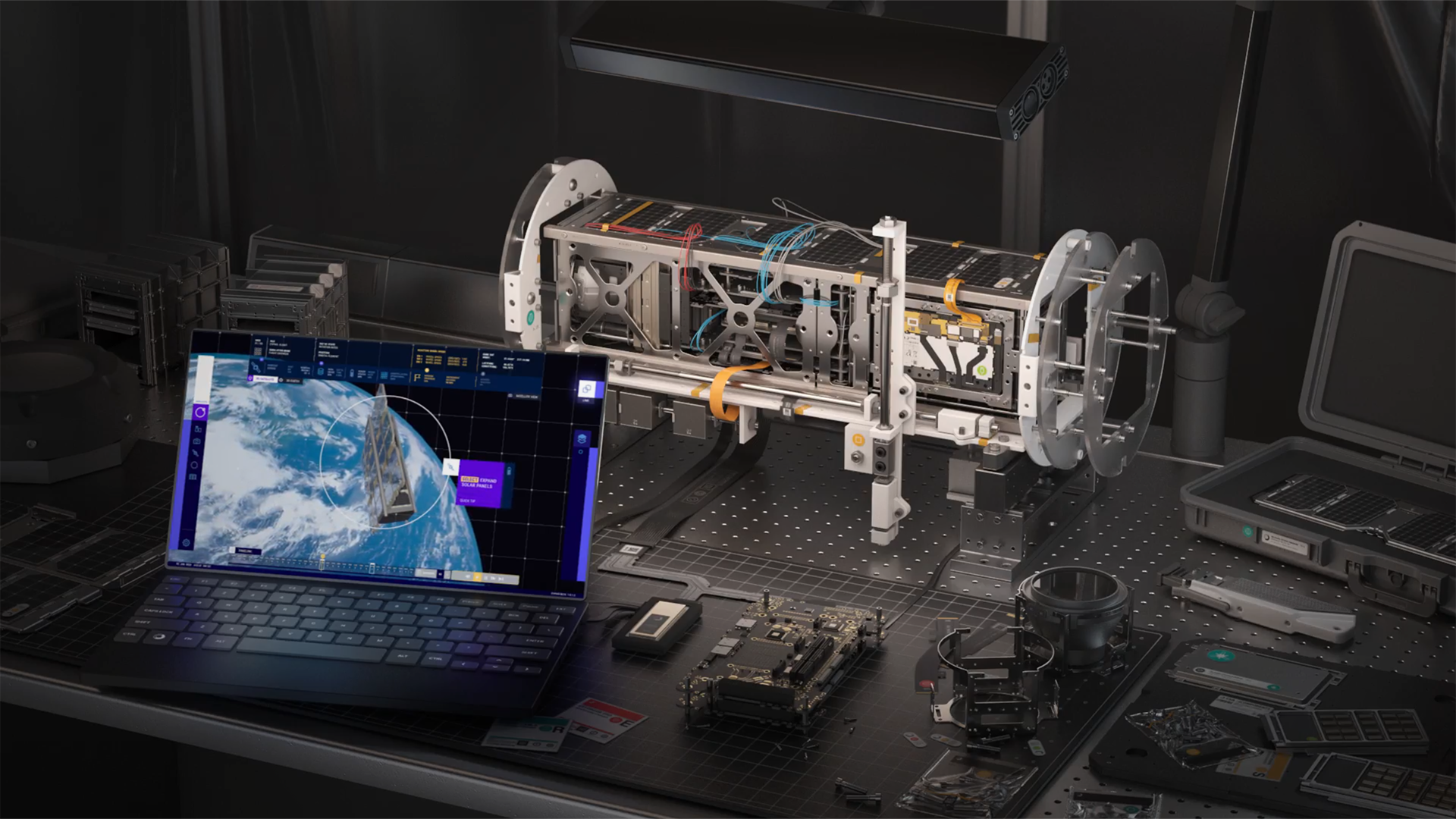4 min read
Rise of Artificial Intelligence in the Space Industry
Artificial intelligence (AI) has been on the rise in recent years due to improvements in machine learning algorithms, increased computational power,...
5 min read
![]() Zendir
:
25/09/2025 5:00:36 PM
Zendir
:
25/09/2025 5:00:36 PM
.png)
Exploring how digital twins are being utilised to progress automation within the satellite industry.
The satellite industry is entering a transformative era. Historically, satellites have depended heavily on human operators for mission planning, anomaly detection, and decision-making. But as the number of satellites in orbit multiplies—driven by mega-constellations, deep-space exploration, and the growing complexity of satellite payloads—the limitations of human-centric operations are becoming apparent. Autonomy is no longer a luxury; it is a necessity.
Yet, advancing autonomy in space is not straightforward. Satellites often operate in data-limited environments, constrained by bandwidth, delayed communication windows, and the sheer physical distances involved, particularly in deep-space missions. For autonomy to be trusted, decision-making systems onboard satellites must not only perform with minimal oversight but also provide confidence to human operators on Earth that they are acting safely and optimally.
At the heart of this transformation lies the concept of digital twins—high-fidelity virtual replicas of physical satellites and their operational environment. By creating a continuous feedback loop between a satellite and its digital twin, engineers and mission controllers can test, validate, and refine autonomous behaviors before and during operations.
This article explores how digital twins are enabling the next leap in satellite automation, the challenges of building trust in autonomous systems under data constraints, and the broader implications for the future of space exploration and industry.
The idea of digital twins originated in manufacturing and aerospace, where companies like NASA and GE pioneered them to predict equipment failures and optimize performance. A digital twin is more than just a simulation—it is a living model that updates in near real time with telemetry from its physical counterpart.
In the satellite domain, digital twins serve multiple purposes:
Design and Testing: Before launch, engineers create digital twins to simulate spacecraft behavior under different conditions. These simulations allow mission planners to identify potential weaknesses and refine designs.
Operations Support: Once in orbit, a satellite’s telemetry can be fed back into its digital twin, allowing operators to assess health, predict failures, and run "what-if" scenarios without risking the spacecraft itself.
Autonomous Validation: For satellites with autonomous decision-making algorithms, digital twins provide a sandbox to test and validate responses to unexpected events—such as collision avoidance maneuvers—before execution.
What distinguishes digital twins from traditional simulations is their dynamic linkage to real-world data, ensuring that the model evolves alongside the satellite. This is particularly powerful in data-limited environments where every bit of downlinked information is precious. Operators can use the twin to interpolate missing data, estimate system health, and maintain operational trust even with incomplete telemetry.
With the rise of mega-constellations such as Starlink, OneWeb, and Amazon’s Project Kuiper, the number of active satellites is projected to exceed 50,000 by 2030. Manually managing each satellite with human operators is not feasible. Autonomy is essential to scale operations without exponentially increasing ground staff.
Exploration missions to Mars, Jupiter, and beyond face communication delays ranging from minutes to hours. For spacecraft navigating such distances, real-time human oversight is impossible. Autonomy enables spacecraft to detect anomalies, perform corrections, and carry out mission objectives without waiting for Earth’s approval.
Satellites today are not just communication relays or imaging devices—they host advanced sensors, AI-driven processors, and experimental payloads. Managing these payloads requires real-time optimization that human operators cannot always provide.
These drivers converge to make autonomous decision-making systems critical. However, without sufficient trust in their reliability, operators may hesitate to grant autonomy, potentially undercutting the benefits.
Trust is the cornerstone of autonomy. For ground operators, handing over mission-critical decisions to algorithms requires assurance that the system will behave as expected—even in unforeseen circumstances.
Transparency: Operators need to understand why an autonomous system is taking a particular action. Black-box decision-making reduces trust.
Validation: Algorithms must be tested extensively in both simulated and live environments to demonstrate robustness.
Predictability: Autonomous behavior should align with operator expectations and mission objectives, avoiding “surprising” actions that could endanger the spacecraft.
Resilience: Systems must handle incomplete or corrupted data gracefully, without cascading failures.
Digital twins address these trust dimensions by providing:
Explainability: Operators can replay decision paths within the twin to understand why a satellite took specific actions.
Safe Experimentation: Engineers can simulate edge cases—like solar flares, sensor failures, or cyberattacks—within the twin before such events occur in orbit.
Predictive Confidence: Twins can forecast satellite behavior under different conditions, allowing operators to anticipate outcomes.
Continuous Monitoring: Even when data is limited, twins can interpolate satellite health and operational status, reducing uncertainty.
Autonomy in terrestrial applications benefits from abundant data. Autonomous cars, for example, process gigabytes of sensor data per second. Satellites, by contrast, must contend with:
Limited Bandwidth: Downlink capacity is often insufficient to transmit all collected data. Operators must prioritize what is sent back.
Latency: Deep-space missions experience significant communication delays.
Intermittent Contact: Satellites in certain orbits may only have periodic windows to communicate with ground stations.
Environmental Uncertainty: Harsh radiation, thermal fluctuations, and micrometeoroid impacts can disrupt sensors, creating data gaps.
The result is that satellites must often make critical decisions with incomplete information.
Space debris poses an increasing threat to satellites. Traditionally, collision avoidance maneuvers are planned on Earth using precise orbital data. But as the orbital environment becomes more congested, satellites may need to autonomously decide whether to execute an evasive maneuver. Doing so with limited or uncertain tracking data requires sophisticated risk estimation and trust in the satellite’s decision-making logic.
In such environments, digital twins act as data amplifiers:
They combine sparse real telemetry with predictive models to maintain a coherent operational picture.
They allow operators to reconstruct missing information with higher confidence.
They enable satellites themselves to test potential decisions internally against their onboard twin, reducing the likelihood of unsafe actions.
For autonomy to thrive in data-limited conditions, significant advances in onboard computing and AI have been necessary.
Satellites are increasingly equipped with AI chips capable of running inference directly in orbit. This reduces dependence on Earth-based processing and allows for real-time decision-making.
FDIR systems allow satellites to autonomously detect anomalies, isolate faulty components, and initiate recovery procedures. Combined with digital twins, these systems can validate corrective actions before execution.
Emerging research explores reinforcement learning (RL) techniques where satellites learn optimal behaviors over time. For instance, an RL-driven satellite might learn how to best allocate power between payloads, communication, and thermal control. To maintain trust, such learning must be constrained within the safe bounds validated by digital twins.
NASA has been at the forefront of applying digital twins to spacecraft. For example, the Orion spacecraft uses digital twin models to monitor its systems during Artemis missions. These models simulate spacecraft responses to ensure crew safety and mission success.
ESA is experimenting with AI-driven collision avoidance, where satellites autonomously process debris-tracking data and decide on maneuvers. Digital twins are used to test these maneuvers on the ground before granting autonomy in orbit.
Companies like Planet and Maxar are exploring onboard AI and digital twins to process imagery directly in space. Instead of downlinking terabytes of raw images, satellites autonomously select and compress the most relevant data for Earth, optimizing limited bandwidth.
Building trust in autonomy is not just a technical challenge; it also involves ethics and governance.
Accountability: If an autonomous satellite takes an action that results in mission failure, who is responsible—the manufacturer, operator, or algorithm developer?
Transparency to Regulators: Space agencies may require explanations of autonomous behaviors to ensure compliance with international treaties.
Standardization: Industry-wide standards for digital twin fidelity, data sharing, and AI validation will be necessary to foster interoperability and trust.
The convergence of digital twins, AI, and advanced onboard computing points to a future where satellites will operate with unprecedented independence. Some emerging frontiers include:
Self-Healing Satellites: Using digital twins to autonomously identify and reconfigure around damaged components.
Collaborative Autonomy: Constellations where satellites share data and decisions among themselves, reducing reliance on Earth.
Explainable AI in Space: Embedding transparency mechanisms so satellites can justify their actions to operators in human-readable terms.
Adaptive Digital Twins: Twins that evolve over the satellite’s lifetime, incorporating new data, mission updates, and learned behaviors.
The satellite industry is standing at the threshold of a new age—one where autonomy is essential, not optional. Yet autonomy cannot succeed without trust, and trust is difficult in the data-limited environments of space.
Digital twins emerge as the bridge between these challenges and opportunities. By providing a dynamic, transparent, and predictive model of satellites, they allow engineers and operators to validate autonomy, compensate for limited data, and build confidence in machine-driven decision-making.
As satellites grow in number, complexity, and distance from Earth, advancing autonomy through digital twins will be crucial to sustainable space operations. The vision is clear: fleets of self-reliant satellites working collaboratively, safely, and intelligently—pushing the boundaries of human exploration while ensuring resilience in the most unforgiving environment known to us.

4 min read
Artificial intelligence (AI) has been on the rise in recent years due to improvements in machine learning algorithms, increased computational power,...

4 min read
From supporting ground control in saving the Apollo 13 astronauts to testing thermal protection on the Space Shuttle, digital twins have been a core...

5 min read
Zendir Joins Global Initiative for AI-Driven Space Sustainability Introduction The race to expand humanity’s presence in space has never been more...